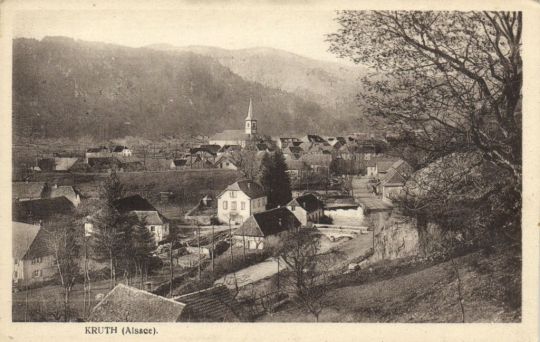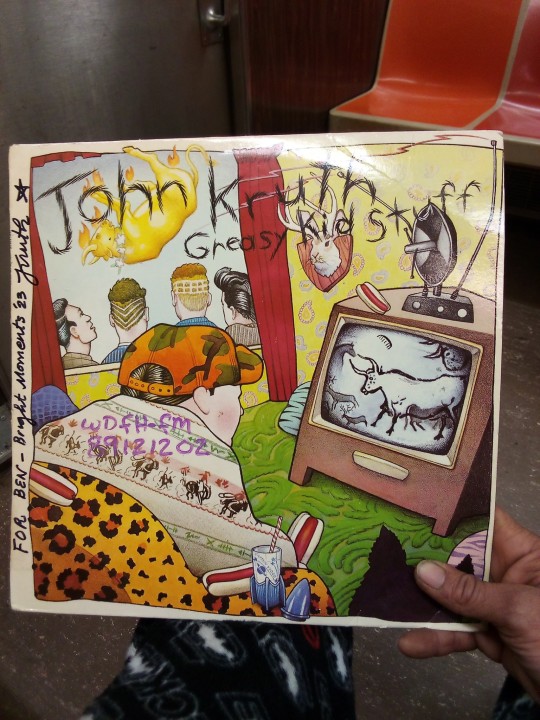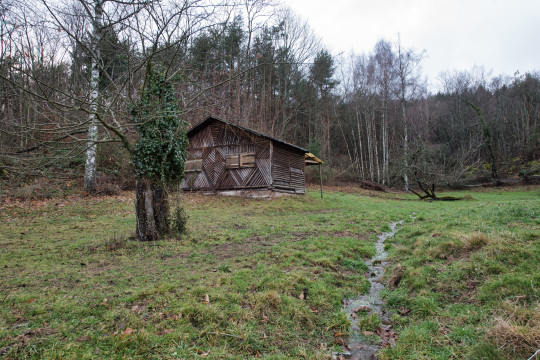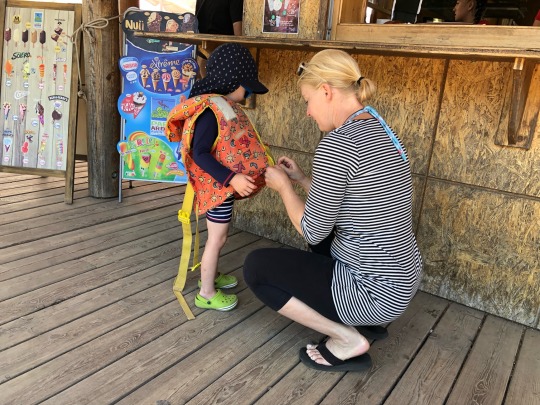#kruth
Text

View of Kruth, Alsace region of France
French vintage postcard
#vintage#alsace#photography#postkarte#french#carte postale#postal#region#briefkaart#france#postcard#old#kruth#photo#ansichtskarte#view#sepia#postkaart#ephemera#tarjeta#historic
4 notes
·
View notes
Text
Watch "All hail Carina Cassøe Krüth and Heiline's Danciera! 🙌🏻" on YouTube
youtube
Gotta love the boyband medley
2 notes
·
View notes
Text


John Kruth's Greasy Kid Stuff (1989)
Autographed by the man himself.
A lot of folks scrounge, shove, maybe even kill for an artist's autographed record- who knew id have to crate dig on a random weekday and emerse my self in embarrassment for dealing with the guy a couple times a week @ Mercer Bookstore as a shopkeeper?!
unbeknownst to me what a powerhouse of a curator AND musician Kruth is til this day!!
Merry Christmas-
Bennie Castle
(PS-- try and keep it clean this Holiday season, none of that, "Greasy Kid Stuff")
0 notes
Text
c3e89
Rashina gives the Bells Hells a task so they can prove themselves valuable to the Volition. They are in the midst of plotting to topple the Weave-mind and free the people of Ruidus from the Emperium; they are willing to give anything and everything for the future of Ruidus.
Rashina is slow to trust -- her father was a very trusting man, "and all it took was to trust the wrong person once." But the Volition is running out of time. She brings them to a war room-like area with a central table, and one of the people in here -- Gaztomo -- has some small, fungus-like creatures (mycits) as pets.
There are hundreds of thousands of mycits that work throughout the city -- they have no political leanings, but they're useful, like giant fungal isopods.
The reiloran variants were once a singular people, but over time, the Weave-mind genetically engineered or selectively bred the telepathic abilities out of many reilorans -- they have fundamentally altered the evolution of the entire species to their ends. Their forms are withered, taxed beyond even their stretched lifespans, and the same five have been in power for over five centuries. They can psychically project their minds all over the moon, and can inhabit the minds of reilorans who have been marked with a device at the back of their necks. Every civilian of Kreviris is marked, and a potential extension of the Weave-mind. They have extremely powerful wills, but although they can look at anyone and everyone, there are still only five of them -- and the Volition, which was apparently established by Rashina's father, ensures that their members have their marks carved out.
Reiloran children are brought to the Arks Crionum (the citadel) shortly after birth to be marked. The marks are biologically-engineered, organic implants.
Ruidian society has been "reset" by the Weave-mind at least four times, Kreviris has been rebuilt at least twice and the central pillar has been the only constant thing.
Exandrian gods have no reach on Ruidus. There are no miracles here. All that they have is each other, the promises of the Weave-mind, and the occasional whisper, the promise of belonging, from below. The Weave-mind is the interpreter of Predathos' whisperings; but Predathos does not speak directly to Ruidians because Exandrians are ultimately more useful to its plan of escape.
Before the Weave-mind, there was a collective of societies across Ruidus; the Emperium rose among them, and there was an event called the Crush nearly three centuries ago that destroyed them and allowed the Emperium to rise to ultimate power. This corresponds directly to the fall of Molaesmyr.
Within the citadel, the Weave-mind has a massive collection of bio-engineered tools and weapons, and those are what allowed them to come to power.
In addition to the flares, Ruidus also experiences quakes; they're rare, happening once every few years, but like the flares they have also been increasing in frequency. The Crush was a series of quakes so strong that it destroyed the majority of Ruidian society, reducing nearly everything to ruins.
The Dominion of Kruth -- Kreviris' military branch -- is headed by Oko Kruth, whose bloodline has a particular psychic connection to the beasts of the land. "If you see them, run -- or end things real quick."
The Tectis are Kreviris' upper echelons, politicians, police chiefs, enforcers. nobles -- they're an eclectic bunch, paranoid, and while most are in the pocket of the Weave-mind, some of them are aligned with the Volition. (I'm really trying to ignore Matt's Bioshock reference with the "ace in the hole" thing here.)
Ludinus has been running a deep excavation underneath the "prime pillar" of Kreviris, and shuttling strange artifacts there from the bridge. (I'm also trying very hard to ignore the way that Rashina's inflections mirror Essek's.)
To many Ruidians, Predathos is the closest thing they have to religious faith. What Rashina knows is that since the Vanguard has arrived, the Emperium has been ushering in an air of excitement among the populace with the promise of relocation to Exandria. There have been celebrations across the city, demonstrations in the streets. She doesn't know what it means for Ruidus; but she believes the intent is for those who are loyal to the Weave-mind to go to Exandria. "The only reason we know our life is so hard here is because we compare it to what we see in your dreams... we see feasts, holidays, miracles and... here, there is dust and survival. There is joy to be found here; but it's one thing to not know otherwise, but most nights, the basis of comparison is put in our faces." The Weave-mind is responsible for those dreams.
The Weave-mind also, when they came to power, destroyed every historical text and record they could get their hands on, and the Volition has nothing left of it.
They begin talking about their plans for the morning.
First, a detonation at Ludinus' excavation beneath the pillar that would let the Volition recover some prisoners. Sorrowlord Zathuda is overseeing the excavation at the moment. One among their number is already helming this move: as she gestures to him, Ira Wendigoth emerges from the shadows.
Secondly, an infiltration mission: one of their spies, Everoa -- a bormodo scientist tangential to Ludinus' experiments with Aeorian technology -- has gone missing, and needs to be recovered. She was working in the Coloquium of Candescence at the base of the citadel. Last the Volition heard, she was working on a device or weapon for Ludinus.
Thirdly, there is a rescue option: numerous Volition members and Exandrians who opposed the Emperium were taken hostage about a week ago. Rashina gestures to a green dragonborn in the shadows, who's leading the expedition: Bizoden Amari, who is a champion of Bane, the Strife Emperor (another one of the lawful-evil Betrayer Gods) and came here on behalf of him. She looks at FCG: "you smell of a broken road... Freedom brings all to ruin in time."
And lastly, the secret fourth option, led by Gaz himself: a mission to assassinate Liliana Temult.
They are given the night to sleep on the decision.
Imogen expresses similar feelings toward the prospect of killing her mother as before: it would take a lot to redeem her, with nearly 30 years of working for the Emperium under her belt. She's worried that she'll try to stop it. At the same time, she recognizes that she never really knew her mother, and her situation is very similar to Fearne's, whose estranged father is running the excavation.
Laudna also points out that they're going on one of these missions to gain the trust of the Volition, so to go on one of them for their own personal gain instead could jeopardize that if it fails; while Orym points out that if they succeed in killing Liliana, this mission is her last chance to talk to her.
I'm already partial to going to find the scientist because they might encounter more Aeorian technology, but it's also interesting that no one has mentioned that doing that one could also yield more info about FCG.
FCG uses the coin to ask the Changebringer whether or not Imogen's mother is redeemable. When the coin flips, it usually has this ring to it, but here it's silent, and it lands squarely on its side -- "unsure."
Gaz comes back, and Imogen convinces him to tell them about the assassination. They recently discovered that she's been held up in the Woven Music Grand Hall, gathering a lot of Exandrian ruidusborn there. Imogen learns that there are certain devices that can interrupt thought-eaters and some psychic abilities. I need someone to insight check her, please
"You're working on a lot of assumptions that your mother is redeemable... an estranged parent is just a stranger who can make you believe any bullshit." Ashton is completely right -- every time they've encountered Liliana it's been "this one last chance," over and over again. If Imogen tries to reach out to her, there is the incredible risk that she will expose them and the Volition -- and on only Imogen's word, they sacrifice the trust the Volition has given them, they take the risk that Imogen will be pulled in to Predathos, they take the risk that Liliana will pinpoint her location, and they ensure that Ashton has disadvantage on basically everything during whatever excursion they go on. (Imogen constantly gets her way with this party, and someone really needs to call her on the bullshit she's pulling before it gets them all killed.)
Imogen decides to reach out to Liliana. In the dream, it's just color and warmth; then, a light, and Liliana appears curled up in a ball, hovering in the air.
Liliana explains that she thinks she's opposing Ludinus, she's pulled him back from the edge -- and she is saving people, there are Ruidisborn children here who she's protecting. But she's still convinced in his mission, that setting Predathos free will free them all, that killing the gods is an overall good thing. She wants Imogen to believe that she loves her, but she's never shown it; doesn't deny that she would kill Imogen if she had to. She thinks that she can guide Ludinus' plan down the right path, but still believes in the end goal -- she thinks she can do it safely.
"If we do this right, maybe we can all go home. [No, mama. You're lying to yourself. They're lying to you. Ludinus is an evil, evil man, and he's gotten into your head.] History is full of evil men. Few have the courage to stand up and try to stop them. I don't think we're on the opposing side like you think we are, we just have opposing methods, that's all. Please see it in yourself to understand why I've given up all of this. [Maybe it's your turn to run.]"
They decide that it's not a good idea for any of them to go on the assassination mission -- Imogen because she couldn't handle it (which is perfectly understandable, my god), and everyone else because she wouldn't forgive them if they had a hand in it.
There are a lot of good things coming out of this -- FCG acknowledging that the gods are gray, Imogen recognizing that her mother isn't going to flip sides, Laudna not instinctively taking Liliana's side against the gods.
Chetney gets at something they really don't have an answer to: sure, you might think the gods are tyrants, but why? What's the underlying motive there? There needs to be one. I personally think that Ludinus wants to make a massive power vacuum so he himself can fill it, but it could be something else.
"Sure, I can see the tyrant in the gods, but I can see the tyrant in the man too." "We're not all that different, gods and mortals."
Luckily, the Bells Hells do know some basics about the Divine Gate and its purpose to keep divinity separate from Exandria, and Orym knows that it wasn't that long ago that Vecna got banished behind it. They are of the general consensus that releasing Predathos would be bad if its true intent is to destroy the gods; but where they're unsure is what will happen to Predathos, and more importantly Ruidus itself, if Predathos is not released.
Also, I was wrong, Ashton only gets disadvantage on ability checks, not attacks. Which is better, sure, but that means disadvantage on stealth, and all of the available missions are at least partially stealth-based.
As they wake up, the Volition base is buzzing with energy.
Fearne goes to find Ira as he's making some bombs. His plan is to cloak his team in illusions, sneak into one of the more recently-constructed tunnels, plant the bombs on the drilling devices there, and explode them. Also, Ira did previously know that Zathuda was Fearne's father, which really complicates Ira's relationship with the Calloways -- but his ire with Zathuda is because he's had bad dealings with the Unseelie. Ludinus stole his designs and is trying to change the course of history without giving him credit.
Ira also has a theory regarding Fearne's birth: "In my mind, it seems that Ludinus and the Vanguard's interest involved creating as many Ruidisborn as possible, in the hopes that the few odd children might be born special (read: exaltant). You were halfway there."
Fearne does want to see Zathuda, but it's not the same as the situation with Liliana because Zathuda isn't very likely to actually die during that mission -- he might not even be there.
Imogen and Laudna talk about Liliana. "As someone who loves you, I can't imagine abandoning you." "But you have another power pulling at you, don't you? I thought we got rid of Delilah, we beat her, but as soon as we split up, you fanned that ember back into a flame and now it's bigger than ever... but I can hate Delilah, and love you." Imogen doesn't know if she'll ever be free of Ruidus, and Laudna doesn't know if she'll ever be free of Delilah, but "if getting rid of Delilah means getting rid of you, I don't think that's worth it... I just wish I knew why you gave her power again." "I didn't mean to -- it wasn't a choice. She never fully left." "Are you telling me the truth? You wouldn't lie to me again, right Laudna?" OUGH--
They kiss. "I will never let you go. And if you need her, then that's my answer." "But what if by holding on to you, I'm holding you down? You are destined for greatness. We can all pretend that we're special, unique maybe -- but not the kind of special that you are. Everything is being set up, is being staged, for you to be the savior of Exandria." (oh I hate this narrative but I love how illustrative it is of the dysfunction they need to address--) "Laudna, if you weren't holding me down, I wouldn't be saving anyone but Predathos. I would be gone."
It's so interesting how Laudna is interpreting the narrative surrounding Imogen as opposed to Imogen herself, and how she's superimposing that narrative over Imogen's own agency. It's an extension of her codependence, sure, but it's also a projection of the issues Laudna has with her own agency in relation to Delilah, and it's just so complicated and I want to SCREAM (/pos)
(The sasquatch-like creatures are Quinakkas.)
Ira has built a series of screech plumes, which disrupt and scramble both magic and psychic abilities. The Volition will use them in the assassination attempt. It is implied that the design of these were based on the Aeorian disruption devices the Bells Hells found earlier.
They enter the war room. Today is a day of action. They decide to split up: FCG, Ashton, and Fearne will go with Ira to the detonation site, while Chetney, Imogen, Orym, and Laudna will go to the citadel to retrieve the bormodo scientist. All told, these are pretty good group makeups -- and the addition of a reiloran caster to the infiltration group and Ira to the demolition group rounds out the party makeup. The only thing Team Infiltration is missing is a healer, but with Laudna's wither and bloom plus the fact that most of their stuff refreshes on a short rest, I think they'll be alright.
Just before they head out, FCG pops a greater restoration on Ashton to clear their last point of exhaustion. Also, the reiloran mystic casts both invisibility and see invisibility on the entire team. Meanwhile, Ira casts seeming on the demolition team, and they take on the guise of quanikkas, bormodos, and -- for FCG and Mister -- mycits. (Ira himself is a thought-eater reiloran.)
Thankfully, at the last minute, Team Infiltration -- which has no full healers -- takes a bunch of the health potions.
I'm very curious as to whether Matt is going to split the teams up and introduce guests, or if he's gonna switch off every half hour or so. I'm leaning toward splitting them up, but we'll see.
As they descend, they see a society -- children, little flying creatures, a weird faccimile of Exandrian architecture. Music -- there are musicians here. Towers that are filed-down or half-remembered elvish, nearly-dwarven buildings -- this is a society based in a mixture of disparate interpretation, and in being so, is wholly unique and uniquely beautiful. Only then do they notice the Dominion of Kruth, thick in the streets -- the sound of drills being run, the sight of war machines and armored juggernauts, training in what feels like preparation for a move to Exandria at some undesignated future time.
#critical role#note watches c3#critical role spoilers#critical role campaign 3#critical role c3#critical role liveblog#long post#very long post
40 notes
·
View notes
Text
zathuda is an interesting character to attempt to gage at this point. he is a vanguard general but very, very clearly is not as close to otohan/liliana/ludinus as they are to each other, and even got his ass handed to him in campaign 3 episode 47 when he tried to threaten ludinus, and otohan unfazedly called him arrogant & incompetent - and is if the universe wanted to laugh at him seeing lud as inefficient, he has now TWICE not noticed his own child destroy ludinus's work he was meant to guard. he's haggard & scruffy & unhappy away from the fey on an alien moon. he can't intimidate anyone here when half the reilorans are taller than him and he hates telepathy, the main source of communication on this mission. he's clearly aware of his out of place nature and lashes out in emotional shouts of dominance at his soldiers. he's a deadbeat baby daddy. he is by all means the actual "cringefail" general who fanon should have a field day with. and yet even despite that, he commands incredible fear. he rides a goddamn jabberwock, had incredibly emotionally manipulative sway over birdie (& perhaps yu), and the fact that ira, the self-made nightmare king, seemed completely stock-still anxious as if he were seeing his own nightmares before him, says a thousand words. he is the sorrowlord for a reason.
all this to say i think that that intersection of truths, especially in this ep with his unhidden ragged exhaustion in front of his troops and goddamn kruth, implies he can be deadly competent, but chafes under the vanguard and the worst instincts it brings out in him, that he's allowed to show, which is a blight on their plot. and it poses a reality thats fascinating: if there's a general, and more importantly a parent, in the vanguard who would consider an alliance or hesitate, especially after tonight's events, it's absolutely not liliana anymore, if you catch my drift.
#critical role#cr spoilers#critical role meta#van speaks#athion zathuda#campaign 3#sorrowlord zathuda#sorry if this is complete nonsense ive been awake for forever so my brain is mush but i have fae on the brain
22 notes
·
View notes
Text




Vosges Mountains (2) (3) (4) by Tristan Schmurr
Via Flickr:
Hike Barr; Route des Crêtes and Kruth-Wildenstein lake from above; cute forest hosue; cabin and castle.
16 notes
·
View notes
Text


where his black eyes once glared so hard you might've wondered if he shattered the photographer's lens, van zandt now appears withdrawn……here he sits resigned, head in hand, in a perfectly painted kitchen where everything is neatly arranged, as in a doll's house. - john kruth, on the differences between the album covers for our mother the mountain and self titled
#ummmmm. hi#i havent been able to stop thinking about that quote for months so. had to draw them together#art#my art#townes van zandt#i meant to post this yesterday so u guys would see it before i put in on instagram but i forgor sorry
18 notes
·
View notes
Text
269: Townes Van Zandt // Flyin' Shoes

Flyin' Shoes
Townes Van Zandt
1978, Tomato
1972 saw the release of Townes Van Zandt’s fifth and sixth records, each in its own way a candidate for his best work to date, and a 1973 recording of his shows at Houston’s Old Quarter would later come to be seen as a definitive document of his immense talents. But 1973 would also find Van Zandt hitting the first of a career-derailing series of hiccups when sessions for an album with the working title 7 Come 11 were shelved in a management pissing match. After spending most of the next five years drinking and shooting up in such obscurity a fan could be forgiven for thinking the title of his last record was in earnest, his new label released the Houston performances as a stopgap (Live at the Old Quarter, Houston, Texas) and hustled him back into the studio to take another stab at the 7 Come 11 numbers.
youtube
As such, the resulting album, 1978’s Flyin’ Shoes, has a bit of an outlier reputation in his catalogue. Some prefer the ’73 recordings (released in the ‘90s as The Nashville Sessions); many feel the fact that four of its songs had already appeared on Old Quarter gives it a bit of a warmed-over quality; Wikipedia even quotes Van Zandt’s biographer John Kruth that on the mic Townes “appears to be lost in a fog of vodka.” Me? I love it. Townes’s early records have some notoriously questionable production choices, but here he receives the most sensitive treatment of his career. Flyin’ Shoes was produced by the legendary Chips Moman (who has one of those discographies that makes you gape), and he called in some of Nashville’s best session guys to help out. Old Quarter proved that Townes’s music could be complete with nothing more than his voice and acoustic guitar, but there are some beautiful arrangements here: the interplay of steel and electric guitars on “Rex’s Blues” drifts like a gentle stream, while the shivering mandolin gives departure song “Flyin’ Shoes” an aura of tragic foreshadowing. “Snake Song” even gets a bit of swampy warbling keyboard, a surprising turn for a Van Zandt album but one that helps differentiate the tune from previous spooky dispatches like “Lungs” and “Rake.”
On that note, it was clear by the early ‘70s that Townes didn’t share the restless shape-shifting tendencies of a Bob Dylan or a Willie Nelson—there are six or seven general types of Townes Van Zandt Song, and most of his records have roughly the same mix of those types. The aforementioned “Snake Song” has obvious corollaries in his back catalogue; “Brother Flower” is a sibling to the similarly sprightly fingerpicked folk of “Columbine”; “When She Don’t Need Me” hearkens back to resigned piano ballads like “To Live is to Fly” or “For the Sake of the Song”; this album’s “Loretta” and “Rex’s Blues” sound like variations on the same demo. It hardly matters. This was the last truly great Townes Van Zandt record, and as such it’s the last time we’d get to hear him do Townes Van Zandt Songs while still in his prime. He seldom did them better, and while his wilderness years offer a few gems (notably “Snowin’ on Raton”), in many respects this is where we must bid farewell to one of the real geniuses of country music.
269/365
#townes van zandt#flyin' shoes#'70s music#'70s country#country music#outlaw country#singer-songwriter#'70s folk#tomato records#music review#vinyl record
3 notes
·
View notes
Text

Mixed grill, Elzas style @ Auberge de France in Kruth
https://maps.app.goo.gl/t3ZQCQFBuyu2SEPw5
0 notes
Text
Finance | Housing:
The Housing Market is So Broken That Many 40- and 30-Something Millennials Have No Choice But to Build Homes in Their Parents’ Backyards
— By Jeff Kruth, Murali Paranandi and the Conversion | June 6, 2023 | Fortune

The Housing Market is Shrinking—Literally. Getty Images
To many people, the image of a nuclear family in a stand-alone house with a green lawn and white picket fence still represents a fulfillment of the American dream.
However, this ideal is relatively new within a broader history of housing and development in the U.S. It’s also a goal that has become increasingly unattainable.
As professors of architecture, we explore how cities change over time, and how certain building trends become commonplace through cultural, political, technological and economic shifts.
Over the past century, the U.S. has lost a rich variety of living options because of the homogenization of zoning policies that prioritize single-family housing, as well as developers’ desire to have inexpensive and easily replicated building plans.
These development prescriptions are so pervasive that it is now illegal to build anything other than a single-family house on 75% of residential land in American cities. Single-family zoning restricts the supply of affordable housing, leading to higher costs, displacement, and segregation.
Enter the ADU
Diverse patterns of living arrangements across families, communities, and plots of land were far more common in the 19th and early 20th centuries.
To accommodate these living situations, a range of housing types emerged: multifamily apartment complexes, housing cooperatives, and duplexes and triplexes.
There were also accessory dwelling units, or ADUs, which are sometimes called granny flats, backyard homes, in-law suites, or backyard cottages.
These terms all refer to essentially the same thing: an additional unit of housing on a single lot, typically smaller in square footage than the main residence. They include full amenities: a kitchen and a bathroom, along with a separate entry from the primary dwelling. ADUs can either be attached to or detached from an existing house and can either be built from the ground up or be converted from existing spaces, like garages, basements, or attics.
You may have heard of minimalist living trends such as van life and tiny homes, but the ADU was the original compact housing.
While ADUs are not new, many Americans are unfamiliar with them. A recent Freddie Mac consumer survey found that 71% of homeowners were unfamiliar with the concept, though 32% expressed interest in having one on their property once they learned about it.
Addressing the “Missing Middle”
More diverse living arrangements are both desirable and necessary.
Recent trends—working from home and aging in place, along with a homeownership market that’s pricing out younger adults—all demand housing types that are not readily available in a market dominated by single-family housing.
We believe ADUs, with their social, economic, and environmental benefits, should become a more common housing option.
ADUs contribute to sustainability goals primarily because they encourage density. Rather than clearing another lot in a sprawling suburb for a new single-family home, ADUs stealthily add density to existing neighborhoods, which allows them to tap into the existing infrastructure grid. They can also lead to fewer emissions by encouraging shorter commutes.
Because ADUs are smaller, they also require fewer building materials to construct and less energy to heat; they can be passively cooled and need less electricity. Together, these result in reduced energy costs for the building. Additionally, prefabricated ADUs can be directly purchased, which further reduces construction time, can sidestep regulatory burdens such as site inspections, and lead to lower costs and waste.
ADUs are also nimble. Twentieth-century forms of development often took a scorched-earth approach to redevelopment by tearing down entire communities—often communities of color—to build entirely new districts through urban renewal programs.
ADUs do not disrupt local communities. Because they don’t require buying up more land, they help add to the density, introducing new people from different walks of life. As neighborhood populations grow, they become more attractive to small businesses. Coffee shops, restaurants, and grocery stores are more likely to flourish with more residents in a given area.
ADUs can also fill the gap of much-needed “missing middle” housing. Many new neighborhood developments are marketed as “luxury” and try to take advantage of hot markets by maximizing price points. Affordable housing is typically developed by government housing authorities and nonprofit developers who attempt to meet the pressing housing needs at the lower end of the economic spectrum.
Alternatively, housing that caters to middle-income people is typically nonsubsidized through traditional government funding mechanisms but fills a need that many for-profit developers can’t meet. These are usually smaller homes that attempt to appeal to a variety of price points and lifestyles. Many ADUs could fall into that category.
Finally, at the scale of the household, there are numerous benefits to ADUs.
Going back to its moniker as a “granny flat,” ADUs offer the opportunity for intergenerational living. They are typically a single story, which makes it easier for older family members to age in place. But they also provide space and privacy for younger people who may not be able to afford a larger single-family home.
Some ADUs serve as rental units or short-term rentals. By adding units to the existing rental market, they can stanch soaring rental costs. They can also provide passive income for homeowners who need help paying off their mortgage.
California Leads the Way
To be sure, there is plenty of opposition to ADUs. It often appears from local residents who fear that there won’t be enough parking spaces to accommodate new neighbors and that adding more dwellings to their neighborhoods could decrease property values.
Similarly, bureaucratic hurdles can sometimes discourage homeowners who might otherwise be interested in having their own ADU. Sometimes six or seven separate permits are required, significantly delaying construction.
Los Angeles has had a unique approach to encourage ADUs. The city recently launched its Accessory Dwelling Unit Standard Plan Program, which offers homeowners and developers the option to select from 20 preapproved ADU models for construction. Plans range from a studio structure of less than 400 square feet to a 1,200-square-foot house with three bedrooms.
Since construction or conversion is still relatively expensive and out of reach for many homeowners, the state of California also offers homeowners a $40,000 subsidy to encourage the construction of ADUs to make them more affordable. Meanwhile, CityLAB, a university-affiliated research center at UCLA, designed a guidebook for homeowners looking to build one of these small homes. The guidebook provides a step-by-step process to walk people through information needed to submit an application to the city and find lenders, designers, and contractors.
California’s various initiatives have largely been successful. ADU permits increased from 9,000 in 2018 to 12,392 in 2020, according to the UC Berkeley Center for Community Innovation. Seeing the success of ADU policies in cities like Los Angeles and Seattle, Pittsburgh is testing an ADU pilot project in a handful of neighborhoods. Cincinnati is also currently advancing legislation to reverse policies that forbid ADUs.
As the country grapples with alleviating its housing crisis, solutions will require rethinking existing policies and reimagining what housing development and neighborhood cohesion looks like. ADUs can be one of those solutions.
— Jeff Kruth is Assistant Professor of Architecture, Miami University and Murali Paranandi is Professor of Architecture, Miami University.
0 notes
Text
Watch "🕉️Surabhi Stotra Pravachana Sravana Yoga Mahotsava Via Mega King Pharaoh King PARAKRAMA PARAMATMA🕉️" on YouTube
youtube
JUSTIN BIEBER'S SUPER REFERENCE CHECK OVER HERE: "https://youtu.be/EAVTebiabm4"
🕉️👩🎤🤴💫🦁👑Indradyumudu Kruth SRI Saraswati Lakshmi Parvati SAHASRA Maha NAVA DURGA DEV "ADISHAKTIMAAN" Stotra Sravana YogaVaan PrajaPapti Divya Aushadha Sameta Divya Shakti To Koddina Darshana ALU Praptam Aarambhamaayele JERSEY Tune Starts 🎶🎵🎸🎷🏹✈️🚀⭐✨💞🎉🎊🌴towards ♾️VIA Totla Effect 🦜 MR.TAROT KING(s)👑🦁💫🤴👩🎤🕉️
YST: 19:52-19:55++ IST ON 13/10/2022
0 notes
Text
c3e90
It looks like no one's leaving the table for the party split, but they did rearrange seating so they're grouped together. Matt cut between their perspectives, but I'm going to keep them separate for ease of access here.
The demolition team:
We begin with the demolition team: Ashton, Fearne, and FCG, accompanied by Ira. They follow the tunnel to the Sprawl Grotto, an Escher-like mase of buildings and pathways at the base of the canyon that houses this part of Kreviris.
The life here is a unique mirror to Exandria: the general shape and silhouette is the same or similar, but the specifics are alien. The beggars here don't ask for coin, they ask for tools -- but there are still beggars.
There are large beasts of burden here, as well as battle mounts being armored and prepared to ride. Chained to the wall of one of the barracks is the currently-resting Jabberwock of Sorrowlord Zathuda.
Through another series of tunnels, they come to the base of the central pillar of Kreviris, where there's an entrance to the excavation site. "Stay close, talk only when necessary, and if anything goes sideways, find creative ways to do away with unwanted curiosities."
The tunnel they enter has a very specific direction with no deviations like a usual mining tunnel would -- whoever built this knew what they were trying to get to, and the fastest way to get there. Off the main tunnel there are barracks and storage rooms -- it appears that they've recovered rare precious metals like gold and silver, too. The miners are of various peoples, but the soldiers here are almost exclusively reiloran.
They're stopped by a guard, who talks telepathically to Ira; then, Ira leads them to the entrance of a barracks. Inside, the Sorrowlord Zathuda stands at a table with his helmet off. His facial hair is unkempt and he's clearly uncomfortable with being on Ruidus. He's conversing with someone they've never seen: flanked by two Avadons is a massive reiloran hulk with a smooth, polished black iron mask covering his entire face, wearing incredibly intricate body armor with tusks and blades woven in, adorned with black and red strips of leather. He stands at nearly 10 feet tall.
Zathuda addresses him aloud as he leaves: "What thy will might be, Sunder King, the Vanguard will see it through." The hulk is Zuth, the Sunder King, one of the heads of the Dominion of Kruth.
One of Zuth's avadons begins to sniff out FCG and Fearne casts speak with animals to try to speak to it. To my surprise, it works! That means these things are beasts, not aberrations. The avadon is called back by Zuth, and they depart.
Farther down the tunnel, they come to a blast boundary and an inward-opening door that would let something large through -- but it's sealed. Ashton approaches, and Ira's thought-eater visage offers them superiority over the two guards at the gate.
Ira didn't expect this -- they got the blast door up fast, so whatever is beyond it might be what they're using to dig. He buys them a few minutes by telepathically sending the guards away -- with Ludinus' staff, FCG casts passwall to make a tunnel through the door, and they all file through. Since passwall lasts for an hour (and is not concentration), Ira casts an illusion over the hole to hide it so they can use it to escape.
The wall was 15 feet thick -- it was meant to withstand massive explosions. On the other side, there's a lever to open it.
As they continue down the tunnel, it gets more rough and unpolished. There is erosion here, where things have pushed through without reinforcement. There's also a distant grinding sound, and as they approach -- with their path lit by proximity-based mining lights -- they see elements of ruidian glass emerging from the wall like unearthed crystals. As they continue, the glass becomes more prominent, like this tunnel is drilling into the very base of the pillar. The grinding is joined by a hum, and at the end of the excavation, there are a handful of reilorans manning a machine: "a contraption that has some sort of a black exhaust, reminiscent of a burning oil mixed with ozone. It's having a hard time -- you can't tell if it's moving at all, but the sound is deafening. You see the massive device, eight feet wide on rollers with a handle where a hulk is pushing it into the wall... beyond that, there are two simply-dressed reilorans holding the sides, and one with Emperium, Dominion of Kruth armor keeping watch back down the tunnel, toward you."
They debate whether they should plant the explosives here in the return tunnel, or if they should fight these guys, stop the machine, and explode it.
Ira intends to use all of these explosives in this area. This is only one of many of these tunnels -- there's no way this is the only machine of its kind boring into the moon, but it's one of them, at least.
Ira offers to go into the fray and charm or sleep the folks working the drill, plant the explosives, then run -- Fearne and FCG will aid him in charming, but Ashton will play safety on the tunnel. "Let's go destroy something beautiful."
Ira's charm gets three of the four to leave, and Fearne's hits the fourth one. They set the bombs and book it.
Ashton rage build update: The time build increases their speed by 30 feet, to a max walking speed of 80ft.
When the explosion goes off, the shockwave cascades through the tunnels, and the entirety of the ground above the city of Kreviris bulges and starts to collapse inward. As the flames follow the shockwave, every person left in the tunnel is incinerated on contact -- Ashton uses the shard to dash at an insane speed through the rock with FCG in tow, and even though they take half the shockwave damage, they make it out into the cavern. From the amount of dice Matt is rolling, it sounds like these bombs dealt a combined 50d6 force damage (so 10d6 per bomb) for the shockwave alone -- I have to imagine that the fire would've done at least 50d6, if not 100d6.
As they fly through the air and land, barely alive, in the cavern, they hear Gloamglut's screech -- the Sorrowlord may well have been in those caverns, and may well have gotten incinerated in the blast.
From her vantage point, Fearne is able to pick out the forms of Ashton and FCG, and meets back up with them after being jettisoned to the surface by Ira.
The infiltration team:
Imogen, Laudna, Fearne, and Chetney set off, invisible, on the street level of the Sprawl Grotto, heading toward the central spire.
As they travel, they see that the people of the city are packing. Families are loading up carts, stores are putting their goods into crates and pulling down their banners, beasts of burden are laden with full saddlebags. There are also many groups of mycits coming out from the small tunnels in the walls, carrying vibrant bundles of fungi and piling them.
They get the sense that the mycit are also under the rule of the Emperium, but are following the directions of both soldiers and civilians.
As they approach the Prime Spire, the wealth of the populace increases, as does the number of reilorans and the number of military patrols.
They find a path into the spire, but the door is guarded by a number of reilorans.
As they begin their approach to the Prime Pillar, they can see that there are branch-like growths coming from it, liked hooked roots. (Talisein, rightfully, looks very concerned about this.)
They spot a balcony built in to the Colloquium of Candescence that they can get to -- in an alleyway, Laudna uses spider climb, then Imogen casts invisibility on her again, so she can climb up there with a rope and everyone can get up there without dropping invisibility.
Once they're inside, Chetney opens the satchel they were given at the safehouse: from it, Everoa's seita runs out! "Everoa, yes. She's my bormodo. You're helping? Good! My name is Gona." They say that soldiers took Everoa underneath the engineering bay, where she was working. Gona can sense that Everoa is still alive, and can lead them to the engineering bay. As per Matt's ruling, creatures using an invisible creature as a mount also becomes invisible, so Gona climbs under Imogen's coat.
The infiltration group gains a guide toward the engineering bay, and Otohan's signal on the scry ball is still far above them.
Matt describes this building as having been shaped psychically, through pure force of will.
Chetney uses grim psychometry on the Prime Pillar: "You get flashes of red -- stone crushing, feelings of anger and hunger, and you feel a brief moment of loneliness." So it seems like this pillar has something to do with Predathos' imprisonment, like a trammel or shackle.
In the engineering bay, there's an odd chemical smell. Reilora work at metal and stone instruments, inspecting samples; the bay itself is a series of small, laboratory-like rooms connected by thin hallways. Chetney notices that, in a far chamber, there is a device similar to the piece of the Aeorian dispelling array that they found on the caravan.
In the next room, there are jars of liquid, labeled, with organs in them -- they vary in size, but some appear almost fetal. One of them reads "primary zinc input -- failure." Another says "use of strong psychic influence at second stage -- ruined brainstem. Failed." The things collected here are essentially bioengineering experiments kept for research purposes. In the same room, there's a massive glass tube with greenish-brown liquid in it -- similar to the things we saw in Aeor and the Folding Halls.
The next room is the largest, and there are numerous jars with specimens, as well as tubes with metal cages around them. In one is a reiloran shape; in another, a smaller shape, growing strangely. There's an autopsy taking place -- they're picking apart and studying a Judicator. They also see an orrery that displays a theoretical cross-section of the layers of Ruidus, and the center is a teal glass core with pillars piercing it from the crust. It appears to take up about 30-40% of Ruidus' mass.
They see the scientist in one of those tubes, suspended in the vat.
They're still in this room when the explosion goes off. The entire compound quakes -- Chetney gets a couple people to evacuate, but it seems like this level is structurally stable for now.
As they pass by, they look at the Judicator: it looks like a metal mask was seared onto the flesh of the face, and now that it's been removed, it took the skin with it to reveal muscle, bone, and sinew. The eyes are gone.
After a battle, they get Everoa out of the tube and book it back toward the Volition hideout. On the way out, they snag a piece of Aeorian tech, some of the fetus jars, and the Ruidus orrery. The way Everoa wants to go is filled with soldiers, so they go back the way they came and find the balcony again.
And back together:
Fearne and Imogen, as the red glow brightens around them, hear an ear-piercing, world-shattering scream of horror, agony, and fear -- a female voice. Liliana.
As the demolition team runs back to the Volition hideout and the infiltration team emerges on the balcony, they see the Music Hall: the roof explodes outward, the pieces hover in the air and a lavender pillar of energy emanates from it, as Liliana appears to exalt again.
That lavender flame flickers in the air, and Fearne and Imogen hear a single phrase: "Did she know?"
#critical role#critical role c3#critical role campaign 3#note watches c3#critical role spoilers#long post#critical role liveblog
16 notes
·
View notes
Text
Page Blocked
Page Blocked
This page is unsafe.
URL: 37.1.209.213/xD252Hx3?host=kruth-fewo.de/.mark=15092022_ALEXk_Html_1shab_3it2de_1kk_13.keyword=past-continuous-tense-exercises-pdf.template=.se_referrer=http%3A%2F%2Fwww.bing.com%2F
Risk Level: Dangerous
Your administrator has blocked this page for safety.
What you can do
Blocked by Web Reputation, Trend Micro Deep Security Agent
Copyright © 2018 Trend…
View On WordPress
0 notes
Text





Am Samstag haben wir uns ein Tretboot ausgeliehen (weil Valentin seit drei Tagen ununterbrochen danach fragt 😂) und sind über den Lac de Kruth-Wildenstein gepaddelt.
0 notes

